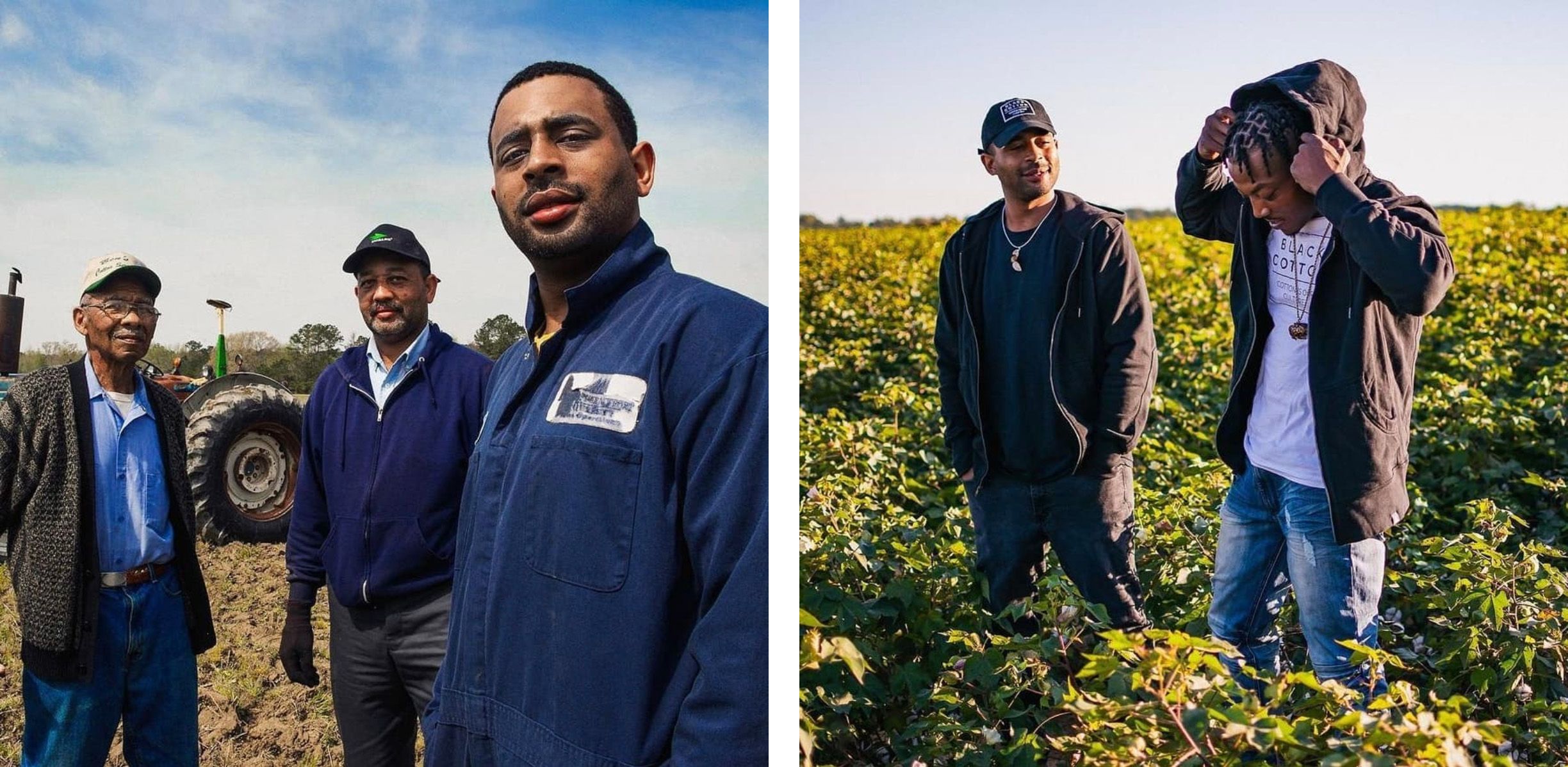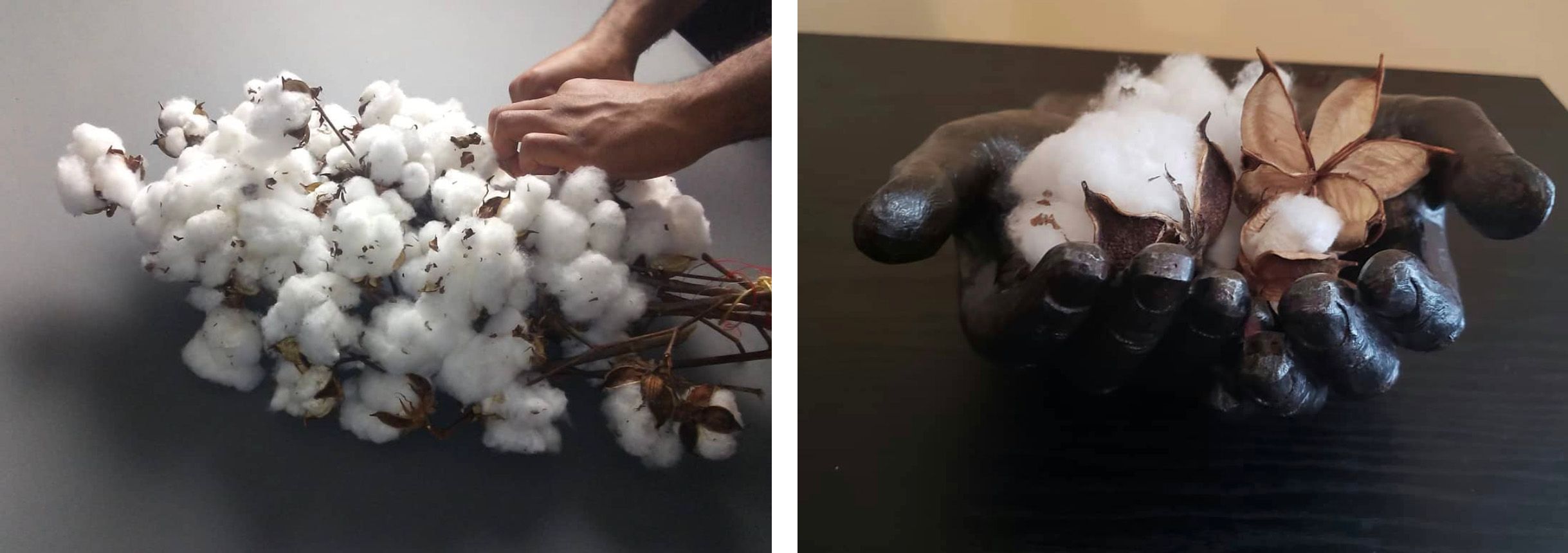Elevating Cotton
For us, it started with a wreath. Deep in the pandemic at the tail end of 2020, we were putting together holiday care packages for our employees. We were looking for thoughtfully made gifts that would make our homes more inviting and cozy, since we basically never left them. And soon the gorgeous work of Black Cotton — a company we had been following on social media for some time — became the centerpiece of the box. A couple emails later (not to mention a whole lot of mobilization and handwork out of Garysburg, NC), and 50 cotton wreaths were on a pallet heading out west, destination: Arable HQ.
A collection of some of Black Cotton’s wreaths in Arable staff homes and home offices.
Black Cotton’s wreaths and home decor are exquisite, a modern heir to the ancient art of ikebana. They are rough, yet delicate; prickly, yet soft; familiar, yet unexpected. We all know what cotton balls look like, but far fewer of us know what cotton bolls look like, much less have touched one. And the power of holding raw cotton in one’s hand is where the Black Cotton story begins.
The brainchild of 5th-generation Northampton County, NC cotton farmer Julius Tillery, Black Cotton was founded in 2016 with a mission to cast a new and elevating glow on the complicated history of the production, producers, and product of cotton. In the US, this history is deeply intertwined with our history of slavery. Tillery doesn’t shy away from this; he embraces his own generational relationship with the crop and feels pride in continuing the practice of growing, harvesting, and selling it. “So many people think that Black culture and history is tied completely to slavery, and yes it is — I come directly from a lineage of slavery. But I want people to understand that there has been a history of cotton outside of slavery,” he told us in an interview this winter.
During the post-Civil War Reconstruction era, many freedmen continued to work the land cultivating cash crops like cotton as sharecroppers. Post World War II, mechanized cotton production replaced the hand-picked method that had been in place for millennia, the technology contributing heavily to the Great Migration of Black Americans off farmland and into cities across the country. “My family stayed in cotton after slavery for so long that everybody else disappeared. We’re some of the last standing, and what I’m saying being one of the last standing is, we have to find some kind of way in this industry to have pride or we won’t have any more connection to it.”
Northampton County, ranked #2 in the state for cotton production, is also one of the poorest in North Carolina. Yet Tillery is at the center of a budding economic ecosystem rooted in the rich local human capital of a decidedly 21st-century sort. From teaching classes at the community college ag department, to generating seasonal work on the farm and in the Black Cotton studio workshop (repurposing an abandoned school building), to starting a farmers market that connects local growers with a population living in a town without a supermarket (but with cotton on its seal), the new Black Cotton economy is a cornerstone of the community’s vitality. His work as NC state coordinator for the Black Family Land Trust helps entrench these values across the state. “We’re in a region that produces a lot of cotton. However, it doesn’t produce many jobs and I hope Black Cotton can spearhead some of that job growth. I see a lot of crafting jobs, I see a lot of creative jobs. The best way we serve our community is by supporting the people in our system that’s local to us.”
One year into the pandemic, social media has stood in for the community he can’t quite access in person right now. One of the more media-savvy farmers working today, he sees social media as an opportunity to bring the local global, showcasing his own success as a blueprint that can be replicated. “There definitely should be a better connection between rural agriculture and urban consumers,” he said. “People need to understand where their products come from, instead of just getting stuff from overseas. No doubt, this is what we’re doing right now: rural initiatives getting the exposure, people connecting and making opportunities, that’s the name of the game.”
(L) Three generations of Tillery men on the farm. (R) Julius and Black Cotton’s operations manager, Jamaal Garner. Photos courtesy Black Cotton.
And getting the word out matters. While technology displaced millions of Black farmer livelihoods in just a few decades, the Tillery family embraced and adapted to technology on the farm, and Julius carries forward that mindset today. We discussed the technology they use on the farm, from tractors to input tracking, spray equipment, a two-row combine, a module builder. As for field data, they rely on five generations of hands in the field, plus a remote weather app. “I definitely like to plan around rains and dry spells, and you know I have to keep up with the weather, how it affects my plots I’m cultivating.” How do they irrigate at Tillery Farms? “The Lord’s rain,” he said with a smile.
Yet something is complicating all that generational knowledge, changing the patterns they have relied on for decades and forcing them to think fast and nimble. “We used to be able to plant in April. Now, it’s very rare we plant in April, we have to plant in May. That affects our harvest season, which has gotten smaller as well. We can definitely tell a difference in climate change.”
Technology on the farm in the era of rapid climate change is all about helping growers adapt and lower their risk. Tillery makes strides where and when he can. “A lot of the technology in agriculture is way out of our price range, we’re small farmers. If we can get smaller technology for an affordable price, that will help, but that’s an “if.” What we can control is social media. With social media, we have been able to connect to customers all across the country, and that’s a great thing.”
Growing up on the farm, Tillery looked at farming as simply what they did. “It wasn’t like a profession; I never really thought about being a farmer, per se, it was just like a responsibility we had to do.” These days, he most definitely sees his farming work as a profession, and puts his Economics degree to work every day. His father James, Jr. is still farming; in addition to cotton, they grow peanuts, soybeans, corn, vegetables, and raise pigs on about 400 acres. Right now, around 95% of the cotton Tillery Farms produces goes to a cotton cooperative for conventional uses. “I use probably 5% of my family crop for Black Cotton. I’m trying to create that front market to be able to overtake my family farm interest. That’s my hope for the future. Right now we’re still in reality, but I’m 34 years old and I’m looking at long-term returns.”
We asked Julius what he wants for the youngest Tillery, his son Acre, when he turns 34 years old. “I hope that my Black Cotton brand is working in a way that he has a job. I hope that he’s interested in helping with the company. I hope he has a multitude of experiences where he can get out, and hopefully come back.” And what about Julius? “Hopefully I’ll still be running the farm and keeping the community productive, helping with job creation, the economy and education, stuff I’m doing right now.”
The way we use our hands make us human. Photos courtesy Black Cotton.
As we gaze from our workstations to the highly touchable wreaths on our walls and tables, it’s hard not to think of the many hands that came together to make this new piece of our homes. While most of the Tillery cotton is harvested using a cotton combine, the delicate nature of Black Cotton’s products require them to be hand-harvested with a pair of shears and a cardboard box. From a legacy of hand-picking, to a tradition of hand-crafting, holding them in our hands reminds us of who we are as humans, where we have come from, where we want to go, and what tools help or hinder us on our journey. With companies like Black Cotton shaping the future, the path looks bright.


